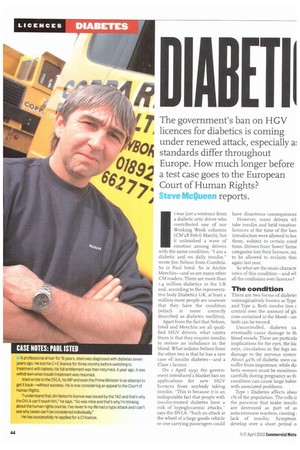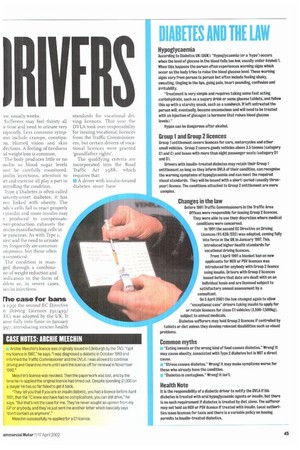ET
Page 44

Page 45

Page 46

If you've noticed an error in this article please click here to report it so we can fix it.
YE
The government's ban on HGV , licences for diabetics is coming under renewed attack, especially a:
A standards differ throughout 44 Europe. How much longer before 40 a test case goes to the European 7. Court of Human Rights? Steve McQueen reports.
t was just a sentence from a diabetic artic driver who contributed one of our Working Week columns (CM 28 Feb-CS March), but it unleashed a wave of emotion among drivers with the same condition. "I am a diabetic and on daily insulin," wrote Jim Nelson from Cumbria. So is Paul Isted. So is Archie Meechin—and so are many other CM readers. There are more than 1.4 million diabetics in the UK and, according to the representative body Diabetics UK, at least a million more people are unaware that they have the condition (which is more correctly described as diabetes mellitus).
Apart from the fact that Nelson, Isted and Meechin are all qualified HGV drivers, what unites them is that they require insulin to restore an imbalance in the blood. What isolates Nelson from the other two is that he has a rare case of insulin diabetes—and a Class 1 licence.
On April 1991 the government introduced a blanket ban on applications for new HGV licences from anybody taking insulin. This is because it is an indisputable fact that people with insulin-treated diabetes have a risk of hypoglycaemic attacks," says the DVLA. "Such an attack at the wheel of a large goods vehicle or one carrying passengers could have disastrous consequences However, some drivers vs+ take insulin and held vocation. licences at the time of the ban introduction were allowed to kec them, subject to certain cond lions. Drivers from 'lower' licenc categories lost their licences, on to be allowed to reclaim the/ again last year.
So what are the main characte istics of this condition—and wI7 all the confusion over licences?
The condition
There are two forms of diabetei unimaginatively known as Type and Type 2. Both involve loss c control over the amount of gh cose contained in the blood—an both can be treated,
Uncontrolled, diabetes ca. eventually cause damage to th blood vessels. There are particula implications for the eyes, the lcic neys, circulation in the legs an damage to the nervous systemAbout 40% of diabetic men cal suffer from impotence, while di2 betic women must be monitor& carefully during pregnancy as th condition can cause large babie with associated problems.
Type i Diabetes affects abou i% of the population. The cells ii the pancreas that make insulii are destroyed as part of al auto-immune reaction, causing lack of insulin. Symptom develop over a short period o -ne, usually weeks.
Sufferers may feel thirsty all Le time and need to urinate very equently. Less common sympms include cramps, constipaan, blurred vision and skin dections. A feeling of tiredness id weight loss is common. The body produces little or no isulin so blood sugar levels lust be carefully monitored. isulin injections, attention to iet and exercise all play a part in introlling the condition.
Type 2 Diabetes is often called taturity-onset diabetes; it has een linked with obesity. The ody's cells fail to react properly insulin and more insulin may e produced to compensate. Iver-production exhausts the isulin-manufacturing cells in le pancreas. As with Type', iirst and the need to urinate ery frequently are common ariptoms, but these often O unnoticed.
The condition is manged through a combinaon of weight reduction and iedication in the form of ablets or, in severe cases, isulin injections.
rhe case for bans
n 1991 the second EC Directive n Driving Licences (91/439/ EC) was adopted by the UK. It ante fully into force in January 997, introducing stricter health
standards for vocational driving licences. That year the DVLA took over responsibility for issuing vocational licences from the Traffic Commissioners, but certain drivers of vocational licences were granted 'grandfather rights'.
The qualifying criteria are incorporated into the Road Traffic Act 1988, which requires that: • A driver with insulin-treated diabetes must have held a Group 2 licence on or after April 1986.
• The Traffic Commissioner must have been aware of the condition before! January 1991.
• The TC must have agreed to the renewal of the licence.
Additional medical requirements include an annual assessment by a consultant with evidence of diabetic control and minimal risk of incapacity due to hypoglycaemia.
According to the DVLA, the complex requirements are dictated by EU regulations. It says: "The driving licence arrangements in Great Britain are governed by the second EC Directive on the driving licence. In relation to Group 2 vehicles, the Directive states: 'Only in very exceptional cases may driving licences be issued to, or renewed for, appli cants or drivers suffering from diabetes mellitus and requiring insulin treatment, and then only where duly justified by authorised medical opinion and subject to regular medical check-ups'."
The DVLA adds that the current blanket ban is based on the views expressed by a House of Commons Science and Technology Committee inquiry in 1999/2000. A DVLA consultative process carried out in 2000 says: "Such drivers are prevented from driving large vehicles on the advice of the Secretary of State's Honorary Medical Advisory Panel on Driving and Diabetes, who considered that the road safety risks were too high to allow this. Other drivers with conditions like epilepsy or visual problems are also legally barred from holding
licences to drive these vehicles."
The DVLA has told CM that the panel felt the ban on drivers using insulin was "based on their knowledge and understanding of the risks of a hypoglycaemic attack, particularly without warning, and the potential dangers to other road users".
The case against
Pressure groups and campaigns led by CM and others such as Diabetes UK (DUK) have already had some influence on the government. In April 2001, the ban on CI licence holders who take insulin was reversed, subject to case-by-case medical checks.
But there is disagreement over the blanket ban elsewhere: "Not every EU state has a blanket ban. Germany, Belgium and Denmark have different procedures to us, although France and Ireland both have blanket bans on Group 2 licences," says DUK.
The DVLA's own consultation document recognises this, but says: "It is for each member state to make a judgement about the extent to which it will implement the Directive and the risks and consequences of not doing so.
"Because the Directive requires mutual recognition of licences, if a driver from another member state travels through the UK his national licence with all its entitlements must be honoured. However, if he becomes resident in the UK he must register with the DVLA and declare his diabetes. He will then be required to surrender his EU licence and will not be allowed to drive Group vehicles here."
According to DUK, the sam House of Commons inquiry tha the DVLA quotes in support c the ban also accepted that ther was "a near absence of evidence to support the policy.
The DVLA has commissionel a research project to make a mor detailed assessment of the riskE This is scheduled to take up t: three years—but DUK fears tha the research is already about . year behind schedule.
A number of anomalies cer tainly exist: cases where driver believe they have been overlooked and should have been given bad their vocational licence (see Casi Notes). It's probably only a matte of time before somebody take. the case to the European Court ot human rights issues. DUK says "We think there could be ground: for a successful appeal. There is proven success rate, as far as dis crimination against people witl diabetes is concerned, at indus trial tribunals."






















































































































































